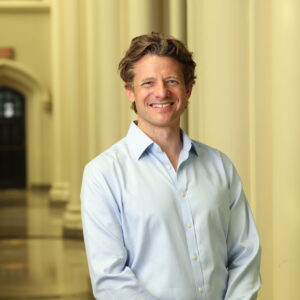When we plug our phones into wall outlets in our homes to be charged, we usually aren’t thinking about the science that’s behind the action.
There is, however, a lot of science that goes into plugging in your phone, your wireless headphones, or your lamp. It starts with an energy source pumping energy into the electrical grid, from which the power flows into substations, is dispersed by power lines into buildings, and is made usable by the outlets in your walls.
At various steps in the process, the power needs to be converted from different voltages and currents. Capacitors are one piece of technology that help in this conversion process and that store energy.

Photo: Courtesy of Stephen O’Brien.
City College’s Dr. Stephen O’Brien is working on developing new nanomaterials to be used in capacitors for better efficiency and effectiveness. O’Brien serves as a professor in the Chemistry and Biochemistry Department and his research interests center around nanotechnology, materials science, and electronic materials.
“Capacitors are a multibillion-dollar industry,” he told The RICC. “It’s a ubiquitous industry and we’re all very used to it. It’s everywhere. There are hundreds of capacitors in your phone and there are thousands of capacitors in the electric car.”
Initially, the lab was creating more basic materials, but as time went on the team began introducing new elements into the compounds to see what properties would develop the process of materials discovery.
He also works on making new multiferroic materials, which attempt to combine both electric and magnetic properties within the same material, which has applications in electronics.
This recent work was spawned from a large project that O’Brien started in 2010. The U.S. Department of Energy’s Advanced Research Projects Agency–Energy funded O’Brien’s “ADEPT Metacapacitors: Power Electronics for LED Lighting” project. The goal of this project was to develop better DC-DC converters, which are a type of energy converter that works with LED lights, among other things. Power converters are essential for the operation of electronic devices and there are many types of designs. There is much room for improving the technology, toward increasing efficiency and flexibility, which can aid in reducing overall GHG emissions or, for example, allow the development of wearable devices.
ADEPT was a collaboration between different disciplines and universities: a consortium model between The City University of New York, The Grove School of Engineering, Columbia University, and the University of California at Berkeley. O’Brien worked with electrical engineers, device engineers, materials scientists, and chemical engineers. The team also worked with Texas Instruments for chip fabrication.

O’Brien and colleagues showing LED lighting technology to the then-director of ARPA-e. Photo: Courtesy of Stephen O’Brien.
“We had this very sort of cross-disciplinary approach,” he said. “When people talk about interdisciplinary science, it’s rather an overused word, right? Everybody kind of knows that that’s the cool thing to do — but this is an example of what that really means. I was really fortunate to have such brilliant collaborators.”
While the ADEPT project is over, it inspired O’Brien to continue working on capacitors and converters at CCNY, both in terms of fundamental materials research and the potential for translational technology.
He first came to work at the school in the early 2000s after working at Columbia University. O’Brien said that coming to City allowed him to work on projects that interested him in a good environment.
“City College is a wonderful institution with a great mission,” he said. “It’s a very fulfilling and satisfying place to be, the mission being that the college is an engine for social mobility. It’s great to be a part of that, you know, to be a small cog in that significant process.”

Amanda is a student at the CUNY Graduate School of Journalism, where she’s studying health & science reporting and broadcast journalism. She graduated from Baruch College in May 2022, where she double majored in journalism & creative writing and political science and double minored in environmental sustainability and communication studies. She has been published in City & State, BORO Magazine, Bklyner, The Canarsie Courier, the New York City News Service, PoliticsNY, Gotham Gazette, Bushwick Daily, DCReport, News-O-Matic, The Queens Daily Eagle, Tower Times, The Ticker, and Dollars & Sense Magazine.